| Release List | Reviews | Price Search | Shop | Newsletter | Forum | DVD Giveaways | Blu-Ray/ HD DVD | Advertise |
| Reviews & Columns |
|
Reviews DVD TV on DVD Blu-ray International DVDs Theatrical Reviews by Studio Video Games Features Collector Series DVDs Easter Egg Database Interviews DVD Talk TV DVD Talk Radio Feature Articles Columns Anime Talk DVD Savant HD Talk Horror DVDs Silent DVD
|
DVD Talk Forum |
|
|
| Resources |
|
DVD Price Search Customer Service #'s RCE Info Links |
|
Columns
|
 |
The Mario Bava Collection
|
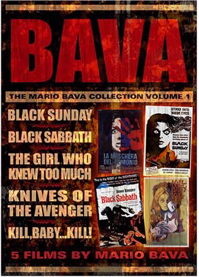
|
Anchor Bay Black Sunday, The Girl Who Knew Too Much, Black Sabbath, Knives of the Avenger, Kill, Baby ... Kill! Directed by Mario Bava 430 minutes Street Date April 3, 2007 49.98 the boxed set |
It's been a full seven years since the Image Mario Bava Collection premiered brilliant European versions of Mario Bava's most noted titles. Besides being a far more economical purchase, the new Anchor Bay Mario Bava Collection Volume 1 adds a pair of desirable new Tim Lucas commentaries to the mix. For fans previously unaware of Bava, this new set is a great opportunity to discover one of horror's most artistic directors.
Inaccurate early announcements led to some disappointment, when websites reported that desirable alternate A.I.P. audio tracks would be included on a couple of the titles. The scope of the package clearly changed over time, because the package was at one point to include Bava's unreleased Erik the Conqueror (1961). We've since been told that that title will be released separately, like Anchor Bay's new disc of Mario Bava's Rabid Dogs (Kidnapped).
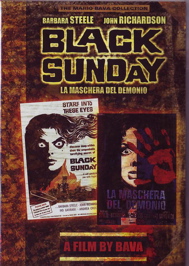
Black Sunday
1960 / B&W / 1:66 anamorphic 16:9 / The Mask of Satan, La maschera del demonio
Starring Barbara Steele, John Richardson, Ivo Garrani, Andrea Checchi
Music Roberto Nicolosi
Producer Massimo de Rita
From a tale by Nikolai Gogol
Screenplay Ennio de Concini and Mario Serandrei
Mario Bava's first credited feature is still the number one film of the Italian Horror renaissance, startlingly original and genuinely creepy. It introduced the icon Barbara Steele to the screen and is probably her best film as well. The blend of vampire and witchcraft lore is atmospheric (all of those real crypts and broken stairs) and violent. This one had a tough ride with the censors both in England and in America.
Black Sunday is also weirdly sexy, no doubt due to Bava's innovative treatment of Barbara Steele as a seductress from beyond the grave. Overturning vampire film conventions, Steele's wicked witch seduces the "Van Helsing" doctor character. He knows she's an illusion, a rotten corpse whose outward beauty is an illusion. He can see the spike-punctures in her face. But he's drawn to her just the same. Never was the misogynistic basis of horror better expressed -- women are Evil because they evoke unclean thoughts in innocent men, and lead them to debase themselves.
Reviewing of this old classic reinforces our memories of Bava's highly kinetic camera direction. His slightly wide lens is forever swooping around candlesticks and craning down to the witch Asa as she writhes in her crypt. The budget may have been low, but Black Sunday is more atmospheric and cinematically active than any of Hollywood's classic horror films.
Image's December 1999 release of this title ushered in a major trend for early DVD, when various smaller companies brought out many unseen Euro-horror films. In the absence of classic Universal and Hammer titles, many of which wouldn't show up for years, Euro-horror slashers, zombie films and gore pictures proved enormously popular with young male early adopters.
The Image disc also debuted a commentary track by Video Watchdog editor and publisher Tim Lucas, who at that time had just announced an exciting career biography of Mario Bava would be published! That fine commentary has been retained on the new disc, along with a similar set of extras.
Transfer-wise, the old Image disc was hard to beat, but Anchor Bay has cleaned up what surface problems still remain on the disc, like a rather large emulsion dig near the end when John Richardson finds a cross that doesn't belong on the neck of the evil witch.
We had hoped to be able to hear La maschera del demonio in one or both of two alternate audio versions -- the Italian original that would completely replace the never-satisfactory English dubbing, or the A.I.P. re-dub, which had even worse dubbing but also Lex Baxter's more animated music score. The Mask of Satan export audio dub here has the preferred Roberto Nicolosi score that leaves many scenes to moody sound effects alone. But Baxter's more aggressive music gave shape to many of the film's transitional scenes and was a better fit for the most horrific moments, as when Asa's empty eye sockets are filled with what look like two glistening fried eggs. Nicolosi's music at that point doesn't seem at all appropriate.
The main menu on the original Image disc has one goodie that we'll miss on the new pressing, the Paul Frees narration that began A.I.P.'s theatrical presentation, heard over a black screen. It's identical to Frees' recordings for the Disneyland Haunted Mansion theme park attraction, a strong memory from Savant's childhood.
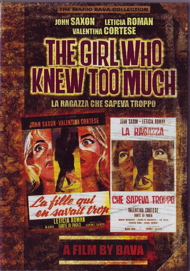
The Girl Who Knew Too Much
1963 / B&W / 1:66 anamorphic 16:9 / La ragazza che sapeva troppo
Starring Leticia Roman, John Saxon, Valentina Cortese, Dante DiPaolo
Cinematography Mario Bava
Art Director Giorgio Giovannini
Film Editor Mario Serandrei
Original Music Roberto Nicolosi
Writing credits Mario Bava, Enzo Corbucci, Ennio De Concini, Eliana De Sabata, and Mino Guerrini
One can see why the superior thriller The Girl Who Knew Too Much wouldn't do well in America -- the abundant dialogue would all have to be dubbed into English. Girl is both funny and scary, kind of a grown-up Nancy Drew story, or "Gidget Goes to Rome and almost Gets Stabbed to Death." Leticia Roman is cute, John Saxon is okay as the love interest and the plot mystery pulls in a stack of eccentric and colorful characters. The beautiful Valentina Cortese looks no older than she did in The House on Telegraph Hill from ten years before.
Without overt supernatural moods to support, Bava's camera instead finds interesting sub-Hitchcockian flourishes in this atmospheric murder tale. Rome's famous Spanish Steps soon become a character in the story. Bava's unique point of view comments on the characters, as when a view under a morgue slab shows only Ms. Roman's nervous hands as she identifies a corpse. Bava adds touches of everyday fantasy. A cluster of nuns' headgear unfolds like a flower to reveal our heroine, just awakening in a hospital bed. Dark rooms have their share of menace, but that mood is frequently undercut by unexpected gags, like John Saxon stumbling in the middle of Ms. Roman's elaborate string traps.
Girl gets a solid B+ in that it almost but not quite attains the level of something like Charade. A wittier script was needed, one that didn't rely entirely on Bava's camera. It eventually boils down to a stylish clichés, complete with a mad killer explicating a murder rationale in a lengthy monologue.
Anchor Bay's B&W transfer improves on the October 2000 Image release, which exhibited many scratches and digs; all but the finest hairline scratches seem to have been removed without an appreciable loss in sharpness. The Furore theme song has a great pop-novelty flavor that places Girl solidly in 1962.
Tim Lucas' new commentary unveils unseen dimensions in The Girl Who Knew Too Much, referring frequently to the A.I.P. re-cut version The Evil Eye, which apparently contains many outright comedy elements and scenes allowed to sustain a lighter tone. Mr. Lucas' analysis of details is often inspired, although I'm not sure I buy his reading of two dress patterns, one 'reflecting the rain washed ground' and another displaying 'a series of knife wounds.' But many of Lucas' associations are convincing, such as Nora's 'reaching into Rome's past' to the story of the Minotaur for a classical protection against intruders. I can help him with one detail -- a final killing reveals two bullet holes in a doorway that stream light, and Tim theorizes that Bava may have invented the gag. I've seen similar bullet holes used at least once before, at the conclusion of Fritz Lang's 1945 Ministry of Fear -- where they also figure in a last-minute killing of the villain.
Perry Martin and Frank H. Woodward provide a new interview featurette with John Saxon. The actor comes off as personable and charming, qualities that aren't always evident in other Saxon docu appearances. Saxon's account of his Italian experience is interesting and believable; he didn't get along too well with Bava, and remembers that the director was oddly superstitious.
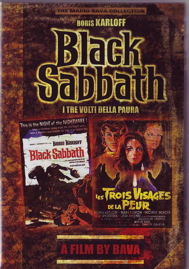
Black Sabbath
1963 / Color / 1:77 anamorpic 16:9 / I tre volti della paura
Starring Boris Karloff, Suzy Andersen, Mark Damon, Glauco Onorato, Rika Dialina, Massimo Righi, Michele Mercier, Lidia Alfonsi, Jacqueline Pierreux, Harriet White Medin
Cinematography Enrico Fontana, Mario Mancini, Ubaldo Terzano
Production Designer Riccardo Dominici
Film Editor Mario Serandrei
Original Music Roberto Nicolosi
Writing credits Mario Bava, Marcello Fondato and Alberto Bevilaqua
Produced by Paolo Mercuri
Directed by Mario Bava
Probably Mario Bava's most accomplished screen gothic, Black Sabbath shows the director excelling with a trio of contrasting horror tales. Bava demonstrates great skill with his actors, giving Boris Karloff what may be his last classic horror role.
With old VHS cassettes becoming a distant memory, fewer Bava fans are familiar with the American-International version of Black Sabbath that changes the order of the stories, softens some of the horror moments and completely disguises the adult content of one episode. AIP jettisoned the tale's lesbian relationship in favor of a rather pointless ghost story.
Image's 2000 release of Black Sabbath was the most beautiful of their Bava transfers, and Anchor Bay's new copy is a definite improvement. Colors are slightly less saturated, but the same effect can easily be replicated by boosting the chroma a bit. The new transfer is much cleaner, with most surface flecks and scratches removed. This reviewer also noticed that specific shots were sharper, like the old lady answering the door of the dead medium in A Drop of Water.
Although we sorely miss not hearing Boris Karloff's distinctive voice, the Italian track provided is in every other respect superior to the A.I.P. re-dub, especially Les Baxter's frequently overdone score. This Italian Black Sabbath leaves many scenes undisturbed by music, to better appreciate the much creepier sound effects.
Lucas' new commentary covers all the bases. He knows the genesis of every location, prop and lighting scheme in every scene. The only stumbles I caught were technical trifles, as when Lucas wants to credit a jump cut in The Telephone to progressive editing, a la 007's Peter Hunt. As with a subsequent jump cut when the two leading actresses enter in The Wurdulak, the edits are simply made to cover fumbles or tighten up the timing. Lucas also wonders why the American version slowed down a shot of a decapitated head hanging from a rafter. It was probably a means of making up for frames lost, without altering the soundtrack, when censors asked that an earlier close-up of the chopped head be shortened.
The interview doc A Life in Film allows actor-producer Mark Damon to tell his impressive career story, starting as a pretty-boy teen actor and ending up as the powerhouse international producer of fine pictures like Das Boot and The Neverending Story. Along the way he joins 50 other people taking credit for Clint Eastwood's hiring as The Man with No Name on Fistful of Dollars. It's certainly possible, as Damon was already established in Italy, although not as a western actor. But beyond belief is Damon's claim that HE gave Roger Corman the idea to do an Edgar Allan Poe story, and came up with the first two titles in the series in exchange for acting in the first (House of Usher) and directing the second (Pit and the Pendulum). Damon asserts that he, and not Corman, directed Vincent Price and the other actors in that film. Authority Tom Weaver has talked to many of the Pit cast and has confirmed that Damon's claims are completely out of line. 1
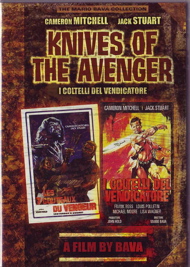
Knives of the Avenger
1965 / Color / 2:35 anamorphic 16:9 / 86m. / I Coltelli del vendicatore
Starring Cameron Mitchell, Elissa Pichell, Giacomo Rossi-Stuart, Fausto Tozzi
Cinematography Antonio Rinaldi
Production Designer Alberto Tavazzi
Film Editor Otello Colangeli
Original Music Marcello Giombini
Written by Alberto Liberati, Giorgio Simonelli and Mario Bava (as John Hold)
Bava's low budget Viking retread of Shane casts the dependable Cameron Mitchell as a conflicted action hero, this time saddled with the unlikely talent of knife throwing. Here a substitute for finesse with a six-gun, the art of throwing knives was never very satisfactory on film. As combat it almost seems like cheating. It's also too easily faked for the camera -- the thrower need only sling his blades wildly, and a judicious cut will reveal a professionally-tossed perfect hit, or one guided by wires.
We're told that Knives of the Avenger was begun by another director and that Bava re-shot about 75% of it. Bava's crisply directed material is often bracketed by lifeless generic setups that we're tempted to assume were the other man's work. The fact that Bava came in late also explains why filming was done in the half-frame Techniscope process that Bava rarely used, if ever. Filmed in a week, Knives looks like every lira of its meager budget made it to the screen, but it is remains one of the director's least interesting pictures. The English-language version is particularly clumsy: after the shortened main credits exit the frame, we continue to watch static shots of a beach for at least forty seconds more. The pace is often slow, with far too many cuts to near-empty beaches. Action scenes in the film's central flashback look rather generic, and too many locations -- like those familiar underground cave-grottoes -- are used unimaginatively. Let's agree that the other director filmed those scenes.
The June 2001 Image release of Knives of the Avenger was something of a disappointment. The enhanced transfer looked fine but no English subtitles were offered to accompany the extra Italian track, forcing us to listen instead to the crude English dub job. The new Anchor Bay transfer gives us the English subs, making Knives immediately more engaging. The new Italian track also seems to be better synchronized. The colors on the widescreen (2:35) image are just as good as the original.
No commentary accompanies Knives of the Avenger, making this the barest entry in Anchor Bay's collection. The same B&W English language trailer returns, with no other new extras. But that Italian track and subtitles win Savant's approval.
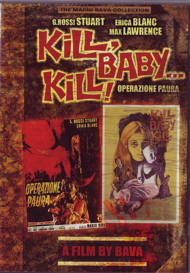
Kill, Baby ... Kill!
1966 / Color / 1:85 anamorphic widescreen /75 83 85 min. / Operazione paura
Starring Giacomo Rossi-Stuart, Piero Lulli, Erika Blanc, Micaela Esdra, Fabienne Dali, Giana Vivaldi, Valeria(o) Valeri
Cinematography Antonio Rinaldi
Film Editor Romana Fortini
Original Music Carlo Rustichelli
Written by Mario Bava, Romano Migliorini, Roberto Natale
Produced by Luciano Catenacci, Nando Pisani
A controversy has been boiling for weeks now over the sudden withdrawal of Dark Sky's Kill, Baby ... Kill! disc, originally scheduled for release one week before this Anchor Bay DVD. Fans have been waiting to find out which disc is the most desirable, and the answer is that this one has a narrow edge. I'll explain further below.
Kill, Baby ... Kill! has become the Bava of choice for committed worshippers of the Italian director. It's a well-developed supernatural tale that reaches beyond its 'mysterious murders' structure to embrace glimpses of the Uncanny rarely seen in other horror films. The doctor hero and his dedicated girlfriend almost solve the bizarre happenings, only to be ensnared in a metaphysical riddle. At least twice in this show, Bava yanks the ground out from under our feet so that we share the hero's dislocation. One time-space warp bests the efforts of mind-bending puzzle pictures like The Saragasso Manuscript: It's more than intellectual ... we feel the pull toward the irrational. In comparison, standard ghost-story ironies such as the conclusion of Danse macabre seem like kindergarten stories.
Women aren't necessarily evil in Kill, Baby ... Kill! but the story has more than its share of interesting female characters: a Miss Haversham-like madwoman, a sorceress, various self-mutilating victims and the film's famous diabolical Little Blonde Girl With The Ball. The diminutive Melissa Graps character was immediately snapped up / borrowed / ripped off by Federico Fellini for his Toby Dammit episode in Spirits of the Dead. She also seems to have single-handedly inspired an entire wave of Japanese "J-Horror" films, where similar figures have recurred since Ringu.
Savant gives this Anchor Bay release the edge over the not-ready-for-store-shelves Dark Sky disc because of its hotly desired Italian language track. Just as Knives of the Avenger is twice as interesting in its language of origin, Kill, Baby ... Kill! also has regained its proper foreign-language distance. The English dub wasn't terrible but the Italian seems like a "real movie" as opposed to a compromised import. This may be a psychological flaw in Savant (language snobbery? horror fan insecurity?), but this Kill, Baby ... Kill! plays like something to be appreciated by adults.
If you don't need an Italian track, then the Dark Sky disc is for you, if and when it surfaces. Tim Lucas' excellent commentary is even more involved than his contributions to these Anchor Bay titles. And David Gregory's superior featurette returns Lamberto Bava to the Kill, Baby ... Kill! location. Anchor Bay's disc offers an English track, a trailer and three Curse of the Living Dead TV spots.
The color transfer is the equal of the Dark Sky disc, so close in quality that I couldn't recommend one over the other. Both are colorful, detailed and cleaned of extraneous grit.
Each disc in Anchor Bay's Mario Bava Collection Volume 1 includes good text bios for Bava and various of his actors, written by Richard Harland Smith. But we miss the extensive insert notes written by Tim Lucas for several of the original Image releases. Lucas' input was very helpful when trying to appreciate the less-than-inspiring Knives of the Avenger, which here is left with nothing to plead its cause.
The slim cases are welcome, but Anchor Bay's attractive but flimsy outside packaging will soon look ragged if not given special care. It's recommended that you immediately remove the anti-theft strip from the bottom of the inner packaging, as the one on the review copy immediately snagged and threatened to tear the inner sleeve.
Anchor Bay certainly has room for improvement on a Volume 2 disc set, as some of the earlier transfers could bear improvement and augmentation with alternate audio tracks -- or improved audio tracks, as on Twitch of the Death Nerve. Bava's necrophiliac masterpiece Lisa and the Devil may never look better -- we're lucky that it exists at all -- but we can always dream. And take a hint, Anchor Bay, ditch the bastardized abomination The House of Exorcism altogether.
Extras in italics below are new to this release. On a scale of Excellent, Good, Fair, and Poor,
|
Black Sunday rates:
Movie: Excellent Video: Excellent Sound: Excellent (English export only -- original Roberto Nicolosi score) Supplements: Audio commentary with Tim Lucas, International and domestic trailers, poster and still gallery, TV spot |
The Girl Who Knew Too Much rates:
Movie: Very Good Video: Excellent Sound: (Italian, English subtitles) Supplements: Audio commentary with Tim Lucas, Interview documentary with John Saxon, International and domestic trailers, poster and still Gallery |
|
Black Sabbath rates:
Movie: Excellent Video: Excellent Sound: Excellent (Italian, English subtitles) Supplements: Audio Commentary with Tim Lucas, Interview Docu with Mark Damon, International and domestic trailers, TV and radio spots, poster and still gallery |
Knives of the Avenger rates:
Movie: Good - Video: Excellent Sound: Excellent (English and Italian, English subtitles) Supplements: Trailer |
|
Kill Baby ... Kill! rates:
Movie: Excellent Video: Excellent Sound: Excellent (English and Italian, English subtitles) Supplements: Trailer, TV spots for Curse of the Living Dead |
Packaging: Five slim cases in thin card sleeve, in thin card slip case Reviewed: March 25, 2007 |
Footnote:
1. This brings up a conundrum for DVD documentarians. When an interviewee says something so clearly untrue, does one cut the statement, or let the interviewee speak his mind? After all, it's his opinion, not the documentarian's. Savant comes from the 'protect the show and protect the talent' school that says it's a showman's duty to prevent interviewees from making fools of themselves. Perhaps more importantly, bad information is being spread -- now there will be people that think Damon directed Pit and the Pendulum.
Return
Review Staff | About DVD Talk | Newsletter Subscribe | Join DVD Talk Forum
Copyright © MH Sub I, LLC dba Internet Brands. | Privacy Policy | Terms of Use
|
| Release List | Reviews | Price Search | Shop | SUBSCRIBE | Forum | DVD Giveaways | Blu-Ray/ HD DVD | Advertise |





